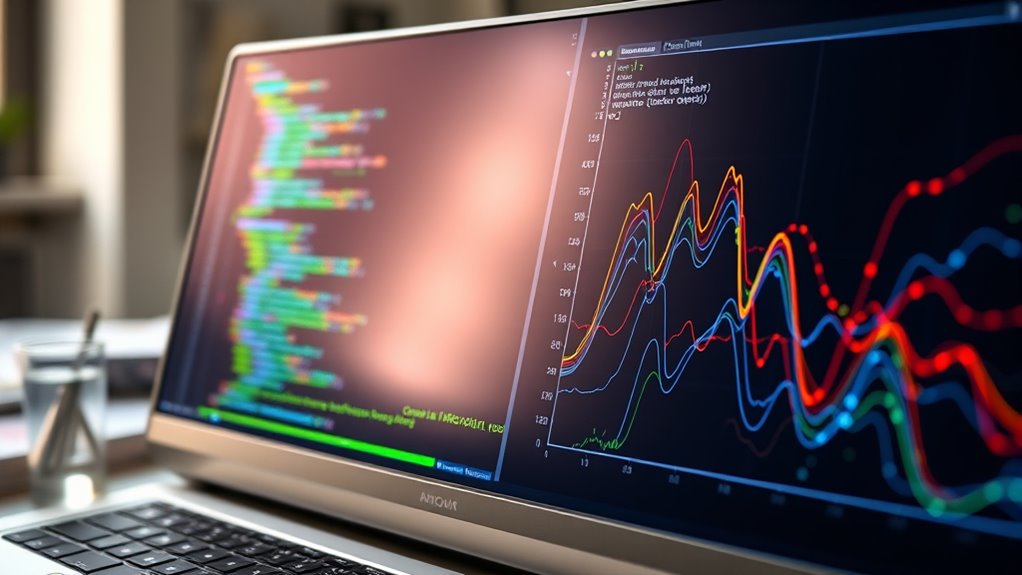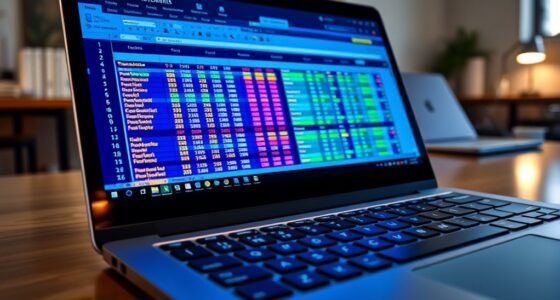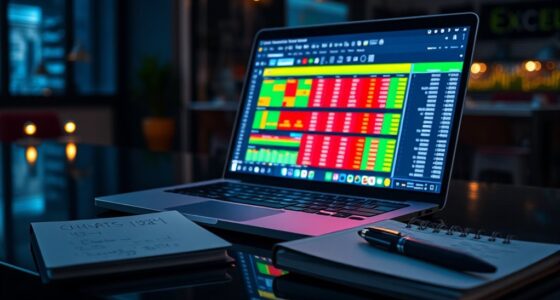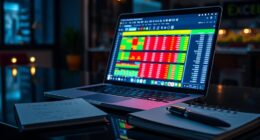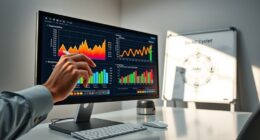You can leverage R’s powerful capabilities for advanced modeling and graphics to analyze complex datasets effectively. Use functions like lm) and packages such as lme4 for mixed-effects models or forecast for time series analysis. Enhance your visualizations with ggplot2 to create residual plots, confidence intervals, and diagnostic charts that validate your models. Mastering these tools will help you communicate findings clearly and efficiently, and exploring further will deepen your understanding of sophisticated data analysis techniques.
Key Takeaways
- Master advanced statistical models like mixed-effects and time series for complex data analysis in R.
- Utilize ggplot2 and other libraries to create customizable, publication-quality graphics for in-depth visualization.
- Implement diagnostic tools and visualizations to validate and interpret advanced models effectively.
- Automate workflows with scripts and packages to streamline repetitive modeling and visualization tasks.
- Integrate modeling and graphics to enhance data storytelling, insight communication, and exploratory analysis.
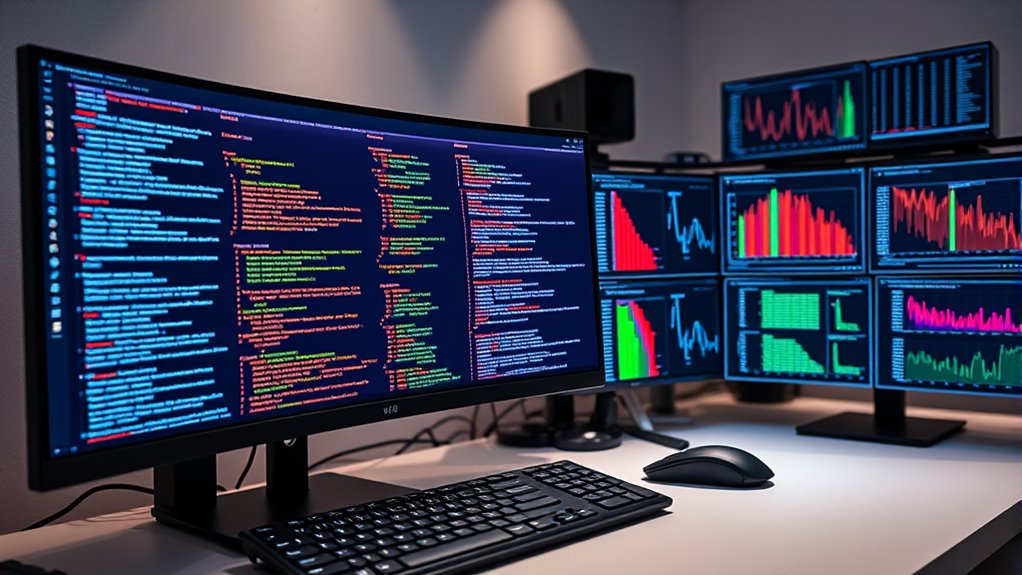
Have you ever wondered how data analysis and visualization are made easier? If you’re diving into R programming, understanding how to leverage its powerful tools for data visualization and statistical modeling is essential. R offers a robust environment that simplifies transforming raw data into insightful visuals, making complex patterns easier to recognize. With R’s extensive libraries, like ggplot2, you can create stunning, customizable graphics that communicate your findings clearly and effectively. When you master data visualization in R, you turn raw numbers into compelling stories, enhancing your ability to interpret data and present results convincingly.
Master data visualization in R to transform raw data into compelling, insightful stories.
Statistical modeling is at the heart of advanced data analysis in R. It allows you to build models that capture relationships within your data, predict future trends, and test hypotheses. R provides a rich set of functions and packages, such as lm() for linear regression or glm() for generalized linear models, that streamline the modeling process. As you work through your data, you’ll learn to select the appropriate model type, fit it efficiently, and interpret the output with confidence. The language’s syntax makes it straightforward to refine models iteratively, ensuring your analysis remains accurate and relevant.
Using R for statistical modeling also opens doors to more sophisticated techniques like mixed-effects models, time series analysis, and machine learning algorithms. These methods enable you to handle complex datasets with multiple variables, temporal dependencies, or non-linear relationships. R’s flexibility ensures you’re not limited by the scope of your analysis, and its active community provides support for implementing cutting-edge models. The synergy between statistical modeling and data visualization becomes especially powerful here, as you can visualize residuals, confidence intervals, and model diagnostics directly within your workflow. This integrated approach helps you validate your models and communicate your insights more convincingly.
Additionally, understanding the capabilities of R in automation can help streamline repetitive tasks and enhance your overall workflow, making your analysis more efficient and reproducible. In essence, mastering data visualization and statistical modeling in R transforms your ability to explore, analyze, and present data. You’re equipped to handle large datasets, identify meaningful patterns, and communicate findings with clarity. Whether you’re creating detailed graphics or building predictive models, R’s capabilities ensure your analysis is both efficient and impactful. As you continue to explore these tools, you’ll find that R’s combination of ease of use and advanced features makes it an indispensable asset for any data scientist or analyst aiming to elevate their work.
Frequently Asked Questions
How Can I Optimize R Code for Large Datasets?
To optimize R code for large datasets, you should leverage parallel processing to distribute tasks across multiple cores, speeding up computations. Additionally, focus on efficient memory management by using data.table instead of data frames, removing unnecessary objects, and avoiding copying data. These strategies help reduce processing time and memory usage, making your code more scalable and responsive when handling extensive datasets.
What Are Best Practices for Reproducible R Scripts?
To guarantee reproducible R scripts, you should incorporate code versioning and detailed project documentation. Use version control systems like Git to track changes and collaborate effectively. Write clear, organized comments explaining your code’s purpose and steps. Additionally, set seed values for randomness, specify package versions, and document your workflow thoroughly. These practices help others reproduce your results reliably and maintain your project over time.
How Do I Integrate R With Other Programming Languages?
Imagine seamlessly connecting R to other languages like Python or C; that’s what interfacing APIs and cross-language packages enable. You can call Python scripts directly from R using reticulate or integrate C code with Rcpp, creating a smooth workflow. To get started, explore existing packages that facilitate these interactions, and write clean, well-documented code. This approach saves time and expands your analytical capabilities across multiple programming environments.
What Advanced Techniques Exist for Visualizing Multidimensional Data?
To visualize multidimensional data effectively, you can explore high dimensional plotting techniques like parallel coordinates, scatterplot matrices, and t-SNE or UMAP for dimensionality reduction. These methods help you uncover patterns and relationships in complex datasets. You might also experiment with interactive visualization tools like plotly or shiny, which allow you to create dynamic, multidimensional visualizations that enhance understanding and insights into your data.
How Can I Automate Complex R Workflows Efficiently?
Imagine your workflow is like a well-oiled machine; automation keeps it running smoothly. To automate complex R workflows efficiently, you should leverage scripting, functions, and packages like drake or targets. These tools help streamline tasks, reduce manual effort, and improve reproducibility. By scripting your processes, you boost efficiency and guarantee consistent results, turning time-consuming steps into quick, automated routines.
Conclusion
So, after mastering advanced modeling and graphics in R, you might think you’re ready for anything. But remember, even with all this power, the data can still surprise you — often when you least expect it. Ironically, what seems like mastery can quickly turn into confusion. Embrace the challenge, because in the world of R, the more you learn, the more you realize how much you still don’t know. Happy coding!

